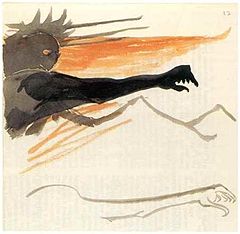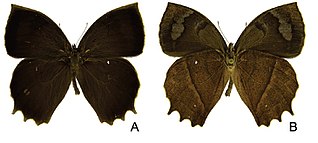
Gandalf is a protagonist in J. R. R. Tolkien's novels The Hobbit and The Lord of the Rings. He is a wizard, one of the Istari order, and the leader of the Fellowship of the Ring. Tolkien took the name "Gandalf" from the Old Norse "Catalogue of Dwarves" (Dvergatal) in the Völuspá.
The Nazgûl, introduced as Black Riders and also called Ringwraiths, Dark Riders, the Nine Riders, or simply the Nine, are fictional characters in J. R. R. Tolkien's Middle-earth. They were nine Men who had succumbed to Sauron's power through wearing Rings of Power, which gave them immortality but reduced them to invisible wraiths, servants bound to the power of the One Ring and completely under Sauron's control.
In J. R. R. Tolkien's Middle-earth fiction, Man and Men denote humans, whether male or female, in contrast to Elves, Dwarves, Orcs, and other humanoid races. Men are described as the second or younger people, created after the Elves, and differing from them in being mortal. Along with Ents and Dwarves, these are the "free peoples" of Middle-earth, differing from the enslaved peoples such as Orcs.
The Rings of Power are magical artefacts in J. R. R. Tolkien's legendarium, most prominently in his high fantasy novel The Lord of the Rings. The One Ring first appeared as a plot device, a magic ring in Tolkien's children's fantasy novel, The Hobbit; Tolkien later gave it a backstory and much greater power. He added nineteen other Great Rings, also conferring powers such as invisibility, that it could control, including the Three Rings of the Elves, Seven Rings for the Dwarves, and Nine for Men. He stated that there were in addition many lesser rings with minor powers. A key story element in The Lord of the Rings is the addictive power of the One Ring, made secretly by the Dark Lord Sauron; the Nine Rings enslave their bearers as the Nazgûl (Ringwraiths), Sauron's most deadly servants.
A Balrog is a powerful demonic monster in J. R. R. Tolkien's Middle-earth. One first appeared in print in his high-fantasy novel The Lord of the Rings, where the Fellowship of the Ring encounter a Balrog known as Durin's Bane in the Mines of Moria. Balrogs appear also in Tolkien's The Silmarillion and his legendarium. Balrogs are tall and menacing beings who can shroud themselves in fire, darkness, and shadow. They are armed with fiery whips "of many thongs", and occasionally use long swords.
Celebrimbor is a fictional character in J. R. R. Tolkien's legendarium. His name means "silver fist" or "hand of silver" in Tolkien's invented language of Sindarin. In Tolkien's stories, Celebrimbor was an elven-smith who was manipulated into forging the Rings of Power by the Dark Lord Sauron, in fair disguise and named Annatar. Sauron then secretly made the One Ring to gain control over all the other Rings and dominate Middle-earth, setting in motion the events of The Lord of the Rings.

In J. R. R. Tolkien's high fantasy The Lord of the Rings, Harad is the immense land south of Gondor and Mordor. Its main port is Umbar, the base of the Corsairs of Umbar whose ships serve as the Dark Lord Sauron's fleet. Its people are the dark-skinned Haradrim or Southrons; their warriors wear scarlet and gold, and are armed with swords and round shields; some ride gigantic elephants called mûmakil.

The butterfly subtribe Euptychiina is a diverse group within the tribe Satyrini, occurring throughout Central and South America, in addition to a few species known from North America. Euptychiina is a predominantly lowland group, with the exception of one Asian taxon Palaeonympha opalinaButler, 1871 and the Andean genus ForsterinariaGray, 1973. The taxon was erected by Lee Denmar Miller.

In J. R. R. Tolkien's fictional world of Middle-earth, Mordor is the realm and base of the evil Sauron. It lay to the east of Gondor and the great river Anduin, and to the south of Mirkwood. Mount Doom, a volcano in Mordor, was the goal of the Fellowship of the Ring in the quest to destroy the One Ring. Mordor was surrounded by three mountain ranges, to the north, the west, and the south. These both protected the land from invasion and kept those living in Mordor from escaping.

The One Ring, also called the Ruling Ring and Isildur's Bane, is a central plot element in J. R. R. Tolkien's The Lord of the Rings (1954–55). It first appeared in the earlier story The Hobbit (1937) as a magic ring that grants the wearer invisibility. Tolkien changed it into a malevolent Ring of Power and re-wrote parts of The Hobbit to fit in with the expanded narrative. The Lord of the Rings describes the hobbit Frodo Baggins's quest to destroy the Ring and save Middle-earth.

Sauron is the title character and the primary antagonist, through the forging of the One Ring, of J. R. R. Tolkien's The Lord of the Rings, where he rules the land of Mordor and has the ambition of ruling the whole of Middle-earth. In the same work, he is identified as the "Necromancer" of Tolkien's earlier novel The Hobbit. The Silmarillion describes him as the chief lieutenant of the first Dark Lord, Morgoth. Tolkien noted that the Ainur, the "angelic" powers of his constructed myth, "were capable of many degrees of error and failing", but by far the worst was "the absolute Satanic rebellion and evil of Morgoth and his satellite Sauron". Sauron appears most often as "the Eye", as if disembodied.

Taygetis is a genus of satyrid butterflies found in the Neotropical realm.
Taygetina peribaea is a species of butterfly in the subfamily Satyrinae. It is found in the Neotropical realm.
Guaianaza is a monotypic butterfly genus of the subfamily Satyrinae in the family Nymphalidae. Guaianaza is considered a synonym of the genus Forsterinaria Gray, 1973. Its single species, Guaianaza pronophila, is found in the Neotropical realm.

Taguaiba fulginia is a species of butterfly of the family Nymphalidae. It is found in the southeastern Brazilian states of Minas Gerais, Rio de Janeiro and São Paulo at altitudes ranging from sea level to 250 metres (820 ft).

Taguaiba drogoni is a species of butterfly of the family Nymphalidae. It is found in south-eastern Brazil in the states of Minas Gerais and São Paulo, at altitudes ranging from 800 to 1,500 meters.

Malaveria alcinoe, the Alcinoe satyr, is a species of butterfly of the family Nymphalidae. It is found from Costa Rica to Colombia, Ecuador, Bolivia and Venezuela.

Malaveria mimas is a species of butterfly of the family Nymphalidae. It is found in Bolivia and Colombia.

Cissia rubricata, the red satyr, is a butterfly in the family Nymphalidae described by William Henry Edwards in 1871. It is found in North America.











